高中英语语法倒装结构
- 格式:pptx
- 大小:2.05 MB
- 文档页数:27
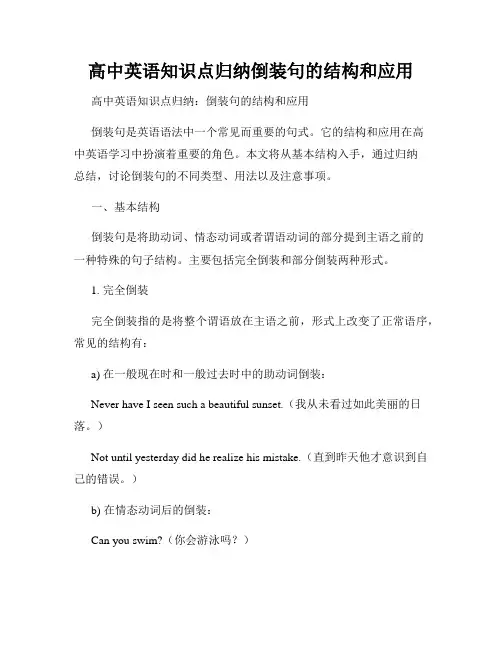
高中英语知识点归纳倒装句的结构和应用高中英语知识点归纳:倒装句的结构和应用倒装句是英语语法中一个常见而重要的句式。
它的结构和应用在高中英语学习中扮演着重要的角色。
本文将从基本结构入手,通过归纳总结,讨论倒装句的不同类型、用法以及注意事项。
一、基本结构倒装句是将助动词、情态动词或者谓语动词的部分提到主语之前的一种特殊的句子结构。
主要包括完全倒装和部分倒装两种形式。
1. 完全倒装完全倒装指的是将整个谓语放在主语之前,形式上改变了正常语序,常见的结构有:a) 在一般现在时和一般过去时中的助动词倒装:Never have I seen such a beautiful sunset.(我从未看过如此美丽的日落。
)Not until yesterday did he realize his mistake.(直到昨天他才意识到自己的错误。
)b) 在情态动词后的倒装:Can you swim?(你会游泳吗?)Should you need any further assistance, please do not hesitate to contact us.(如果您需要进一步的帮助,请随时联系我们。
)2. 部分倒装部分倒装是将谓语的助动词、情态动词或者be动词及其主语中的一部分提到句首,形成倒装句。
这种结构较为灵活,可以用于各种句子类型中。
a) 含有否定意义的副词或词组引导的倒装:Never have I been so embarrassed.(我从未感到如此尴尬。
)Under no circumstances should you reveal your password.(在任何情况下你都不应该透露密码。
)b) 含有“only”引导的倒装:Only in this way can we solve the problem effectively.(只有这样我们才能有效地解决问题。
)Only when he left did she realize how much she loved him.(只有在他离开之后她才意识到自己有多爱他。
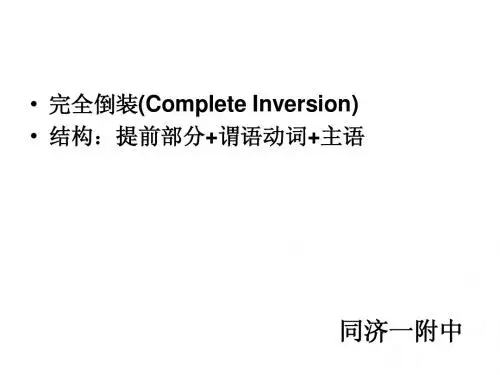
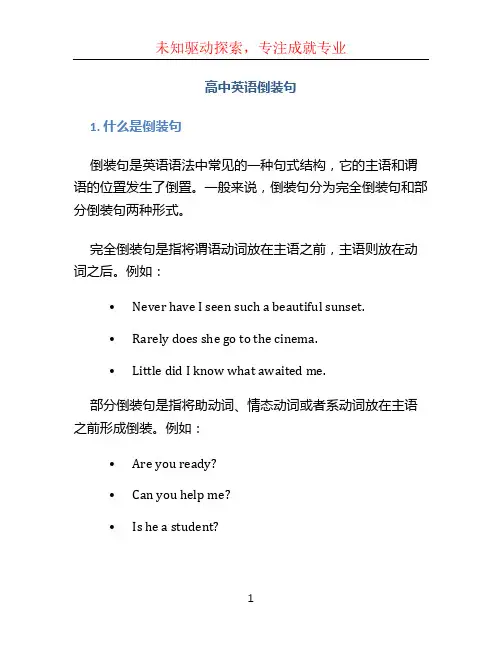
高中英语倒装句1. 什么是倒装句倒装句是英语语法中常见的一种句式结构,它的主语和谓语的位置发生了倒置。
一般来说,倒装句分为完全倒装句和部分倒装句两种形式。
完全倒装句是指将谓语动词放在主语之前,主语则放在动词之后。
例如:•Never have I seen such a beautiful sunset.•Rarely does she go to the cinema.•Little did I know what awaited me.部分倒装句是指将助动词、情态动词或者系动词放在主语之前形成倒装。
例如:•Are you ready?•Can you help me?•Is he a student?2. 完全倒装句的构成完全倒装句的基本结构是:助动词/情态动词/系动词 + 主语 + 谓语。
当句首是否定词、副词、以及表示部分否定的词汇时,就需要使用完全倒装句。
下面是一些例子:•Never have I seen such a talented musician.•Rarely does he get up early on weekends.•Seldom do you find such a peaceful place in a bustling city.需要特别注意的是,当主语是第一人称时,助动词/情态动词/系动词也需要做相应的变化。
例如:•Little did I realize that time would fly so fast.•Only can we learn from our mistakes.•Not until recently have I started learning French.完全倒装句主要用在以下几种情况下:2.1 否定词+动词以否定词开头的句子,通常需要使用倒装结构。
例如:•Never have I seen such a beautiful sunset.•At no time did she mention her plans to me.2.2 副词/短语有些副词或短语放在句首时,也需要使用倒装结构。
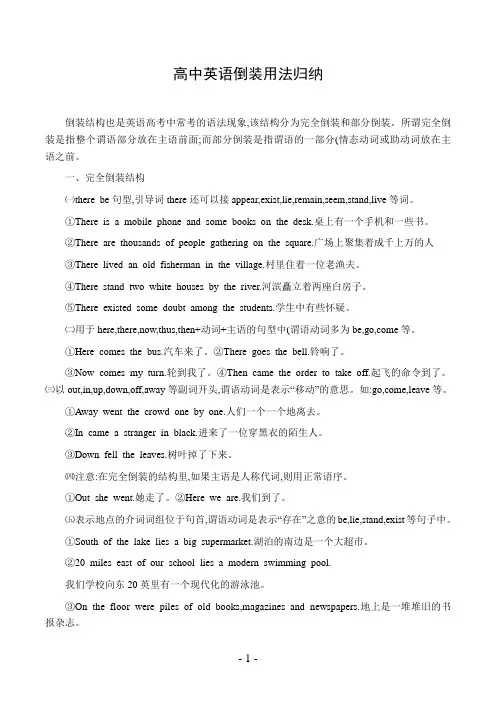
高中英语倒装用法归纳倒装结构也是英语高考中常考的语法现象,该结构分为完全倒装和部分倒装。
所谓完全倒装是指整个谓语部分放在主语前面;而部分倒装是指谓语的一部分(情态动词或助动词放在主语之前。
一、完全倒装结构㈠there be句型,引导词there还可以接appear,exist,lie,remain,seem,stand,live等词。
①There is a mobile phone and some books on the desk.桌上有一个手机和一些书。
②There are thousands of people gathering on the square.广场上聚集着成千上万的人③There lived an old fisherman in the village.村里住着一位老渔夫。
④There stand two white houses by the river.河滨矗立着两座白房子。
⑤There existed some doubt among the students.学生中有些怀疑。
㈡用于here,there,now,thus,then+动词+主语的句型中(谓语动词多为be,go,come等。
①Here comes the bus.汽车来了。
②There goes the bell.铃响了。
③Now comes my turn.轮到我了。
④Then came the order to take off.起飞的命令到了。
㈢以out,in,up,down,off,away等副词开头,谓语动词是表示“移动”的意思。
如:go,come,leave等。
①Away went the crowd one by one.人们一个一个地离去。
②In came a stranger in black.进来了一位穿黑衣的陌生人。
③Down fell the leaves.树叶掉了下来。
㈣注意:在完全倒装的结构里,如果主语是人称代词,则用正常语序。
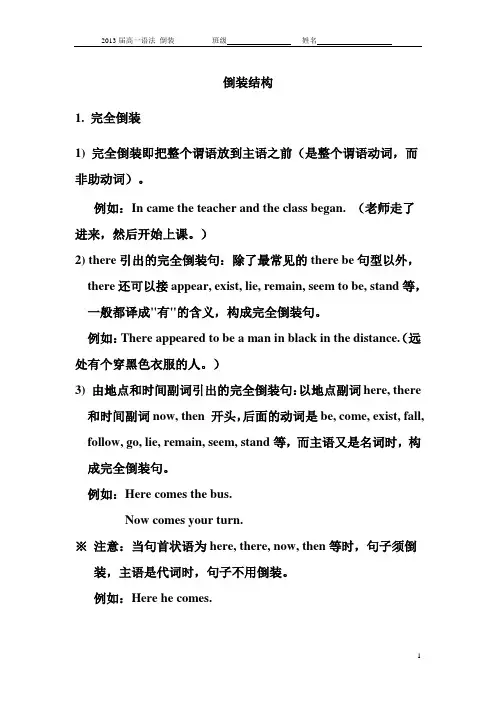
倒装结构1. 完全倒装1) 完全倒装即把整个谓语放到主语之前(是整个谓语动词,而非助动词)。
例如:In came the teacher and the class began. (老师走了进来,然后开始上课。
)2) there引出的完全倒装句:除了最常见的there be句型以外,there还可以接appear, exist, lie, remain, seem to be, stand等,一般都译成"有"的含义,构成完全倒装句。
例如:There appeared to be a man in black in the distance.(远处有个穿黑色衣服的人。
)3) 由地点和时间副词引出的完全倒装句:以地点副词here, there 和时间副词now, then 开头,后面的动词是be, come, exist, fall, follow, go, lie, remain, seem, stand等,而主语又是名词时,构成完全倒装句。
例如:Here comes the bus.Now comes your turn.※注意:当句首状语为here, there, now, then等时,句子须倒装,主语是代词时,句子不用倒装。
例如:Here he comes.4)表示运动方向的副词或地点状语置于句首,谓语表示运动的动词且主语是名词时使用完全倒装例如:Up went the plane.. the plane went up.In came the chairman.注意:如果主语是代词则不发生倒装。
例如:Out they rushed!Lower and lower he bent.5) 在直接引语之后在叙事性书面语中,直接引语后常跟asked Mary, answered John, said the old lady, grunted Peter之类的词语。
在这些词语中,动词常的主语之前。
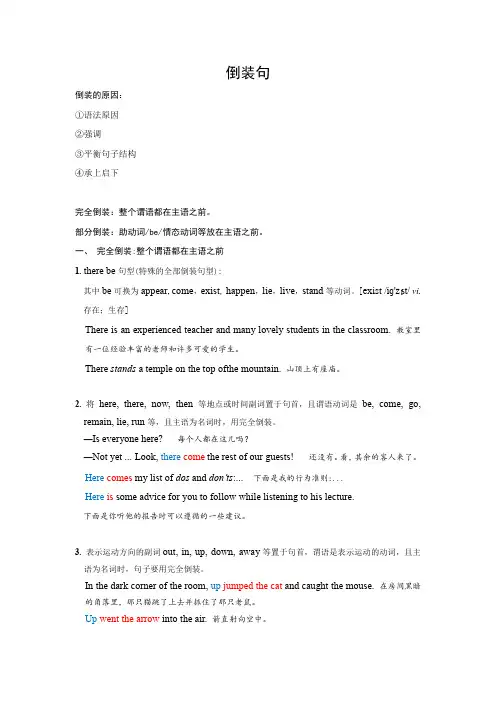
倒装句倒装的原因:①语法原因②强调③平衡句子结构④承上启下完全倒装:整个谓语都在主语之前。
部分倒装:助动词/be/情态动词等放在主语之前。
一、完全倒装:整个谓语都在主语之前1. there be句型(特殊的全部倒装句型):其中be可换为appear, come,exist, happen,lie,live,stand等动词。
[exist/iɡ'zɪst/ vi.存在;生存]There is an experienced teacher and many lovely students in the classroom. 教室里有一位经验丰富的老师和许多可爱的学生。
There stands a temple on the top ofthe mountain. 山顶上有座庙。
2. 将here, there, now, then等地点或时间副词置于句首,且谓语动词是be, come, go, remain, lie, run等,且主语为名词时,用完全倒装。
—Is everyone here? 每个人都在这儿吗?—Not yet ... Look, there come the rest of our guests! 还没有。
看,其余的客人来了。
Here comes my list of dos and don’ts:... 下面是我的行为准则:...Here is some advice for you to follow while listening to his lecture.下面是你听他的报告时可以遵循的一些建议。
3. 表示运动方向的副词out, in, up, down, away等置于句首,谓语是表示运动的动词,且主语为名词时,句子要用完全倒装。
In the dark corner of the room, up jumped the cat and caught the mouse. 在房间黑暗的角落里,那只猫跳了上去并抓住了那只老鼠。
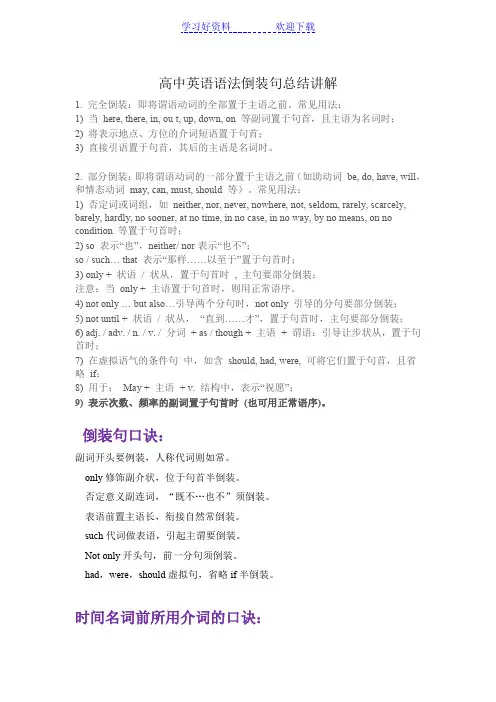
高中英语语法倒装句总结讲解1. 完全倒装:即将谓语动词的全部置于主语之前。
常见用法:1) 当here, there, in, ou t, up, down, on 等副词置于句首,且主语为名词时;2) 将表示地点、方位的介词短语置于句首;3) 直接引语置于句首,其后的主语是名词时。
2. 部分倒装:即将谓语动词的一部分置于主语之前(如助动词be, do, have, will,和情态动词may, can, must, should 等)。
常见用法:1) 否定词或词组,如neither, nor, never, nowhere, not, seldom, rarely, scarcely, barely, hardly, no sooner, at no time, in no case, in no way, by no means, on no condition 等置于句首时;2) so 表示“也”,neither/ nor表示“也不”;so / such… that 表示“那样……以至于”置于句首时;3) only + 状语/ 状从,置于句首时, 主句要部分倒装;注意:当only + 主语置于句首时,则用正常语序。
4) not only … but also…引导两个分句时,not only 引导的分句要部分倒装;5) not until + 状语/ 状从,“直到……才”,置于句首时,主句要部分倒装;6) adj. / adv. / n. / v. / 分词+ as / though + 主语+ 谓语:引导让步状从,置于句首时;7) 在虚拟语气的条件句中,如含should, had, were, 可将它们置于句首,且省略if;8) 用于:May + 主语+ v. 结构中,表示“祝愿”;9) 表示次数、频率的副词置于句首时(也可用正常语序)。
倒装句口诀:副词开头要例装,人称代词则如常。
only修饰副介状,位于句首半倒装。
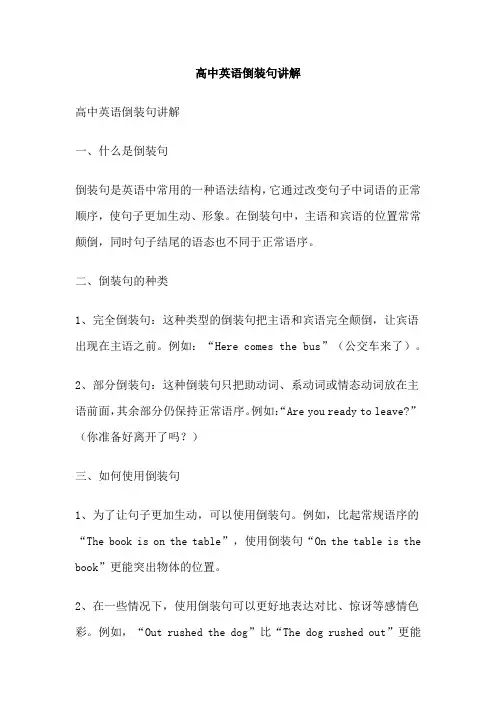
高中英语倒装句讲解高中英语倒装句讲解一、什么是倒装句倒装句是英语中常用的一种语法结构,它通过改变句子中词语的正常顺序,使句子更加生动、形象。
在倒装句中,主语和宾语的位置常常颠倒,同时句子结尾的语态也不同于正常语序。
二、倒装句的种类1、完全倒装句:这种类型的倒装句把主语和宾语完全颠倒,让宾语出现在主语之前。
例如:“Here comes the bus”(公交车来了)。
2、部分倒装句:这种倒装句只把助动词、系动词或情态动词放在主语前面,其余部分仍保持正常语序。
例如:“Are you ready to leave?”(你准备好离开了吗?)三、如何使用倒装句1、为了让句子更加生动,可以使用倒装句。
例如,比起常规语序的“The book is on the table”,使用倒装句“On the table is the book”更能突出物体的位置。
2、在一些情况下,使用倒装句可以更好地表达对比、惊讶等感情色彩。
例如,“Out rushed the dog”比“The dog rushed out”更能表达出狗冲出来的急迫感。
3、在一些疑问句中,为了更好地表达疑问点,需要使用倒装句。
例如,“Did he go to school yesterday?”比“Did he go to school?”更加具体。
四、注意事项1、在使用倒装句时,要注意句子的逻辑性和连贯性,避免出现歧义或误解。
2、在写作中,要根据文章的整体风格和语境来选择使用倒装句,不要过度使用,以免影响阅读体验。
3、在学习倒装句时,要掌握不同类型的倒装句的语法规则,并通过大量的阅读和写作实践来提高自己的语感和应用能力。
总之,掌握英语倒装句对于提高英语表达能力和写作水平都非常重要。
通过深入理解倒装句的语法规则,正确运用倒装句,可以让我们的英语表达更加生动、丰富,更具有表现力和感染力。
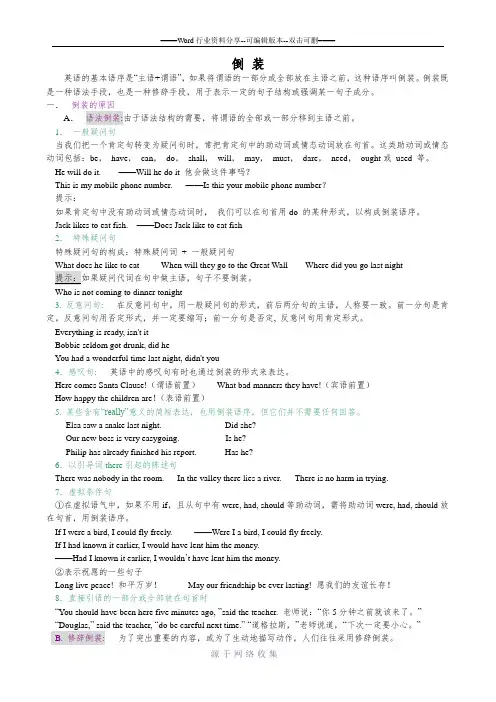
倒装英语的基本语序是“主语+谓语”,如果将谓语的一部分或全部放在主语之前,这种语序叫倒装。
倒装既是一种语法手段,也是一种修辞手段,用于表示一定的句子结构或强调某一句子成分。
一.倒装的原因A.语法倒装:由于语法结构的需要,将谓语的全部或一部分移到主语之前。
1.一般疑问句当我们把一个肯定句转变为疑问句时,常把肯定句中的助动词或情态动词放在句首。
这类助动词或情态动词包括:be,have,can,do,shall,will,may,must,dare,need,ought或used 等。
He will do it. ——Will he do it 他会做这件事吗?This is my mobile phone number. ——Is this your mobile phone number?提示:如果肯定句中没有助动词或情态动词时,我们可以在句首用do 的某种形式,以构成倒装语序。
Jack likes to eat fish. ——Does Jack like to eat fish2.特殊疑问句特殊疑问句的构成:特殊疑问词+ 一般疑问句When will they go to the Great Wall Where did you go last nightWho is not coming to dinner tonight3. 反意问句: 在反意问句中,用一般疑问句的形式,前后两分句的主语,人称要一致。
前一分句是肯定,反意问句用否定形式,并一定要缩写;前一分句是否定, 反意问句用肯定形式。
Everything is ready, isn't itBobbie seldom got drunk, did heYou had a wonderful time last night, didn't you4.感叹句: 英语中的感叹句有时也通过倒装的形式来表达。
Here comes Santa Clause!(谓语前置)What bad manners they have!(宾语前置)How happy the children are!(表语前置)5. 某些含有“really”意义的简短表达,也用倒装语序,但它们并不需要任何回答。
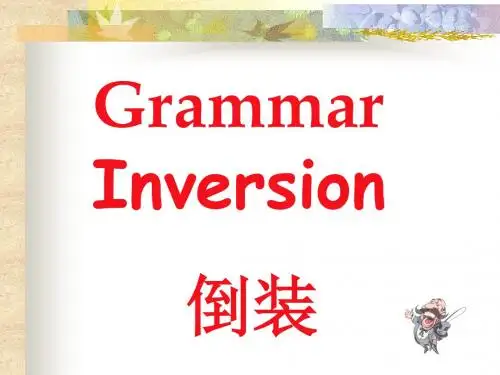
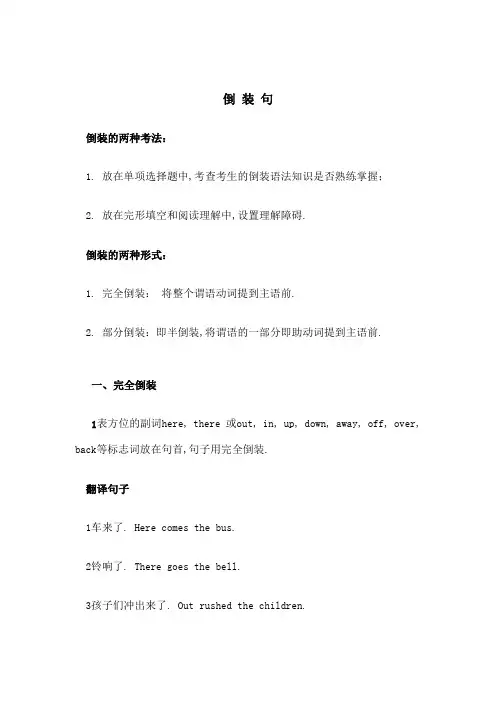
倒装句倒装的两种考法:1. 放在单项选择题中,考查考生的倒装语法知识是否熟练掌握;2. 放在完形填空和阅读理解中,设置理解障碍.倒装的两种形式:1. 完全倒装:将整个谓语动词提到主语前.2. 部分倒装:即半倒装,将谓语的一部分即助动词提到主语前.一、完全倒装1表方位的副词here, there 或out, in, up, down, away, off, over, back等标志词放在句首,句子用完全倒装.翻译句子1车来了. Here comes the bus.2铃响了. There goes the bell.3孩子们冲出来了. Out rushed the children.4那个男孩离开了. Away went the boy.疑难Here it is.In she came.Away he went.疑难剖析当主语是人称代词时,主谓语序不变.2地点状语放在句首且谓语动词为come, live, lie, go, sit, stand等时用完全倒装.完成例句5河的南面有一家小工厂.In south of the river lies a small factory. 6山谷里传来一声喊叫.From the valley came a cry.3 such, the following等放句首时,句子要完全倒装.翻译句子7Such are the facts. 情况就是如此.8生活就是这样. Such is life.9The following is the answer to the question. 这个问题的答案如下.4There lie / exist / stand / live +主语+…是there be 句型的变式翻译句子10山顶上有一幢高楼.There is a tall building on the top of the mountain.11山顶上耸立着一座古塔.There stands an ancient tower on the top of the mountain.5“表语+系动词+主语”的结构.例句观察Present at the party were Mr. Green and many other guests.出席晚会的有格林先生,还有一些别的宾客.Seated on the ground are a group of young men. 坐在地上的是一群年轻人.注意此时,主语较长,可还原为正常语序即:主+系动词+表语.二、部分倒装将情态动词、助动词、be提到主语前. 通常可以还原为正常的语序,并以此检验倒装句是否正确.1含有否定意义的副词或短语如:few, little, never, not, nowhere, rarely, seldom, at no time, by no means, in no case等放在句首时,需用部分倒装.翻译句子12Little does he know about the news. 他对这消息知之甚少.13By no means can he catch up in such a short time. 他根本不可能在这么短的时间里赶上来.疑难1He is active in personality, and he seldom stays indoors. 无助动词He is active in personality, and seldom does he stay indoors. 添加does疑难剖析1若原句中没有助动词,必须根据谓语动词的具体时态来确定相应的助动词do, does 或did.完成例句14—我有大量的工作要做.— I've got an enormous amount of work to do.—我也是.—So have I.15他,和他全家人一样,相信你是无辜的.He believed, as did all his family, that you were innocent. 16如果她不同意这个计划,Tom也不会同意.If she doesn‘t agree to the plan, neither will Tom.2so / as / neither / nor 为标志词放在句首时,句子用倒装.①表示前面所说的肯定情况,也适合于另一人或物时,句式如下:so / as + be 助动词或情态动词+主语.②表示前面所说的否定情况也适合于另一人或物时,句式如下:neither nor+ be 助动词或情态动词+主语.特别提醒①“so +主语+助动词或be动词”表示对上文肯定的内容加以肯定或赞同,意为“的确如此”;— It's raining hard. 天下着大雨.— So it is. 是的.②“主语+did +so”表示:“主语”这样做了. 例如:Tom asked me to go to play football with him and I did so. Tom要我去踢足球,我去了.3①“only +状语或状语从句”放在句首时,句子用部分倒装.②only之后跟的不是状语时不可倒装.完成例句17你只有用这种方法才能学好英语.Only in this way can you learn English well.18只有他有时间的话他才会来.Only if he has time will he come here. 19他被请了3次才来开会.Only after being asked three times did he come to the meeting.20Only that boy can work out the problem. 只有那个男孩才能解答出这个问题.21Only socialism can save China. 只有社会主义才能救中国.4在if引导的虚拟语气条件句中,从句谓语有助动词were, had, should 时,可将if 省略,而把 were, had, should 移到句首.翻译句子22如果我是你,我就不会那样做. Were I you, I wouldn't do that.特别提醒①若从句是否定句,则必须将 not放在主语后.② had必须是助动词.5在“so…that” 和“ such…that”结构中,将“so+adj. ”和“such+n. ”提到句首时,句子用部分倒装.完成例句23暴风雨如此厉害,整个屋顶都被吹掉了.So terrible was the storm that the whole roof was blown off. 24杰克是如此聪明的孩子,他能解答所有这些难题.Such a clever boy was Jack that he was able to work out allthese difficult problems.6often, always, once, many a time, now and then, every the other day, then等状语位于句首时,句子部分倒装.完成例句以前我经常提到他.Often did I speak of him.他常常帮助我做实验.Many a time has he helped me with my experiment.7在not…until…, no sooner…than…, scarcely/hardly…when,not only…but also…, neither…nor…,等否定词开头的句式中.完成例句约翰知道昨天才改变了主意Not until yesterday did John change his mind.她一坐下,电话就响了.Hardly had she sat down when the phone rang.他没去拜访她,他也不会这样做.Neither has he called on her,nor will he do so.她不但说的正确,而且说的流利.Not only did she speak correctly, but also she spoke fluently.8当as /though引导让步状语从句时,可出现“N/adj/adv/分词+as +S+V”或“V+as+S+助动词”的倒装形式.当表语是名词时,名词前不加任何冠词.完成例句尽管他们很勇敢,但这样的危险仍使他们感到畏惧.Brave as they were, the danger made them afraid.尽管他是孩子,但是他知道的很多.Child as he is, he knows a lot of things.虽然尝试了,但是她打不开门.Try as she might, she couldn’t get the door open.8当may 放句首,表达祝愿时,句子倒装.May you succeed.。
高中英语语法倒装句谓语或谓语的一部分放在主语之前的语法现象,就称之为倒装。
从倒装的形式来看,可分为完全倒装和部分倒装两大类。
前者是指整个谓语置于主语之前,而而后者仅指助动词、情态动词或be动词等置于主语之前。
一. 完全倒装完全倒装又可称为全部倒装。
完全倒装是只将句子中的谓语动词全部置于主语之前。
此结构通常只用于一般现在时和一般过去时。
常见的结构有:(1)here,there,now,then,thus等副词置于句首,谓语动词常用be,come,go,lie,run等表示来去或状态的动词。
例如:Then came the teacher. 那时老师来了。
Here is your letter. 你的信。
(2)表示运动方向的副词或地点状语置于句首,谓语表示运动的动词。
例如:Ahead sat an old woman. 前面坐着一个老大妈。
注意:上述全部倒装句型结构的主语必须是名词,如果主语是人称代词则不能完全倒装。
例如:Here he comes. 他来了。
Away they went. 他们走开了。
二. 部分倒装部分倒装是指将谓语的一部分如助动词或情态倒装放到主语之前。
如果句子的谓语没有助动词或情态动词,则需添加助动词do,does 或did,并将其置于主语之前。
(1)句首为否定或半否定的词语,如no, not, never, seldom, little, hardly, at no time, in no way, not until…等。
例如:Never have I seen such a performance.从未见过如此糟糕的表演。
Nowhere will you find the answer to this question.无论如何你不会找到这个问题的答案的。
Not until the child fell asleep did the mother leave the room.母亲一直到孩子入睡后才离开房间。
倒装句英语句子的主语通常位于谓语动词之前,这种语序被称为正常语序。
但有时出于强调或某种特殊的语法结构的需要,需要将谓语动词放在主语之前,这种语序则叫倒装语序。
按倒装的形式,倒装可分为两类,一是完全倒装,二是部分倒装。
完全倒装是指全部谓语放在主语之前,部分倒装是指只把助动词、情态动词或be动词放在主语之前,谓语的主体部分仍在主语之后。
一、完全倒装1. 用于there be 句型。
例:There are many students in the classroom.原句自然顺序是:Many students are there in the classroom.★2. 表示地点的here 和there 位于句首时,其后用完全倒装形式。
这类倒装句的谓语通常是动词be 和come, go 等表示移动或动态的不及物动词,以及stand, lie, live 等表示状态的动词(表示存在)。
例:Here comes the bus. 公共汽车来了。
There goes the last train. 最后一班火车开走了。
There stood a desk against the wall. 靠墙放着一张书桌。
注意:若主语为人称代词,则不倒装。
如:Here you are. 这就是你要的东西。
(给你。
)Here it comes. 它来了。
★3. 表示方向的副词away, down, in, off, out, over, round, up 等位于句首时,其后用完全倒装语序。
这类倒装句的谓语通常表示动态的不及物动词。
Out rushed the puppy. 小狗冲了出去。
Away went the girl. 那个女孩走远了。
Down came the rain and up went the umbrellas. 下雨了,伞都撑起来了。
注:若主语为人称代词,则不能用倒装。
如:In he comes. 他走了进来。
高中英语语法:特殊句式之倒装句一、全部倒装全部倒装就是把句子的谓语动词前置到主语前面构成的倒装句。
★1、表示方向、地点、位置移动或时间的副词,比如in、out、down、off、away、now、then、here、there等置于句首且主语是名词时,句子用全部倒装。
◇Here comes the bus. 公交车来了【但当主语是人称代词时,句子不倒装。
比如Here she comes.她来了】◇Now comes your turn. 现在轮到你了。
◇Up went the fireworks into the air.嗖的一声,焰火上了天。
★2、表示存在的there be句型,主语在be之后。
除了be外,还可使用lie,live,come,exist,sit,stand,remain等不及物动词。
◇ There are so many things to learn today.今天有很多东西要学。
◇There exists an ancient temple in this town,which attracts many visitors.这个镇上有一个古代庙宇,吸引着许多游客。
3、介词短语放在句首作状语,谓语动词是lie, stand , sit ,exist , stretch , come等或系动词be,主语是名词时。
◇At the foot of the mountain lies a clean stream.山脚下有一条清澈的小溪。
4、代词such放在句首,句子的谓语动词是be。
◇Such is what he wanted.这就是他想要的。
5、为了保持句子平衡,使上下文紧密街接,常将表语和状语放在句首,引起主语和谓语的倒装。
◇Gone are the days when we used foreign oil.我们用“洋油”的时代一去不复返了6、现在分词、过去分词、形容词、副词等有时可移到句首,来对动作或状态加以强调。